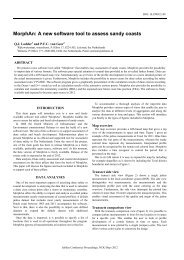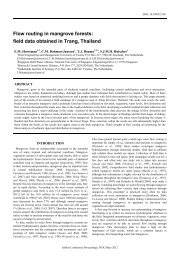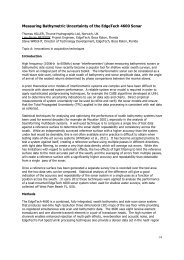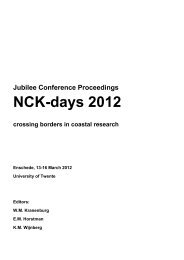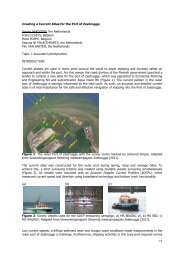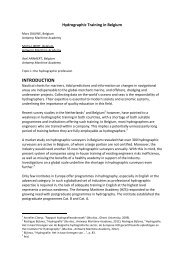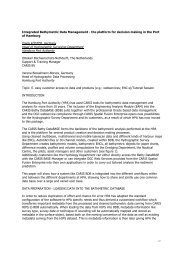Y. Kirkels The article concept below is based on ... - UT Proceedings
Y. Kirkels The article concept below is based on ... - UT Proceedings
Y. Kirkels The article concept below is based on ... - UT Proceedings
You also want an ePaper? Increase the reach of your titles
YUMPU automatically turns print PDFs into web optimized ePapers that Google loves.
Y. <str<strong>on</strong>g>Kirkels</str<strong>on</strong>g><br />
<str<strong>on</strong>g>The</str<strong>on</strong>g> <str<strong>on</strong>g>article</str<strong>on</strong>g> <str<strong>on</strong>g>c<strong>on</strong>cept</str<strong>on</strong>g> <str<strong>on</strong>g>below</str<strong>on</strong>g> <str<strong>on</strong>g>is</str<strong>on</strong>g> <str<strong>on</strong>g>based</str<strong>on</strong>g> <strong>on</strong> my PhD project regarding the<br />
character<str<strong>on</strong>g>is</str<strong>on</strong>g>tics of brokers. It represents the bas<str<strong>on</strong>g>is</str<strong>on</strong>g> of the first <str<strong>on</strong>g>article</str<strong>on</strong>g> of four.<br />
Yv<strong>on</strong>ne <str<strong>on</strong>g>Kirkels</str<strong>on</strong>g><br />
Ph<strong>on</strong>e: 0877 876285<br />
E-mail: y.kirkels@f<strong>on</strong>tys.nl<br />
D<str<strong>on</strong>g>is</str<strong>on</strong>g>cern the inv<str<strong>on</strong>g>is</str<strong>on</strong>g>ible: SME network across Design and Technology
Y. <str<strong>on</strong>g>Kirkels</str<strong>on</strong>g><br />
INTRODUCTION<br />
Over the past decades, alliance networks have proven to be vital to firms. While<br />
most of the attenti<strong>on</strong> in the literature has been paid to the alliance activities of<br />
large multinati<strong>on</strong>al corporati<strong>on</strong>s, especially small and medium sized enterpr<str<strong>on</strong>g>is</str<strong>on</strong>g>es<br />
(SMEs) seem to benefit from the opportunities associated with strategic<br />
partnering. In their effort to survive and overcome resource scarcities small and<br />
medium sized enterpr<str<strong>on</strong>g>is</str<strong>on</strong>g>es are increasingly looking for competent partners that<br />
provide them with complementary assets and resources. In today’s dynamic<br />
envir<strong>on</strong>ment no company can seem to afford to go it al<strong>on</strong>e. Many studies in the<br />
SME field have traditi<strong>on</strong>ally c<strong>on</strong>centrated <strong>on</strong> the importance of involving<br />
suppliers, customers, research institutes and external professi<strong>on</strong>als into the SME<br />
firm’s operati<strong>on</strong>s. Organizati<strong>on</strong>s have been argued to benefit from the ideas,<br />
resources and knowledge of external partners. In particular SMEs are too small<br />
to have all the resources needed to compete in today’s marketplace. Porter<br />
(2000) argues that much of competitive advantage lies outside a given company<br />
or even outside its industry. Firms in various industries indeed increasingly<br />
interact (Hagedoorn, 2002) and they are becoming part of growing networks. In<br />
particular in high-tech sectors, technological dynamics are so fast that almost no<br />
single firm <str<strong>on</strong>g>is</str<strong>on</strong>g> able to keep up with their rapid changing envir<strong>on</strong>ments <strong>on</strong> their own<br />
(Duysters, 2001). Small innovative firms even tend to rely more heavily <strong>on</strong><br />
technological developments outside the firm than large firms in their efforts to<br />
obtain new knowledge (Hicks and Hedge, 2005). Smaller firms have undoubtedly<br />
less resources of their own than large firms, but they generate more innovative<br />
output than expected. <str<strong>on</strong>g>The</str<strong>on</strong>g>ir relati<strong>on</strong>s with others provide informati<strong>on</strong> about<br />
opportunities in their envir<strong>on</strong>ment and enable them to exploit knowledge<br />
spillovers (Audretsch and Lehmann, 2005).<br />
<str<strong>on</strong>g>The</str<strong>on</strong>g> growing importance of networks requires that SMEs thoroughly understand<br />
its character<str<strong>on</strong>g>is</str<strong>on</strong>g>tics, so they can use th<str<strong>on</strong>g>is</str<strong>on</strong>g> knowledge to their own advantage.<br />
Although SMEs are believed to provide vital energy and stimulate growth
Y. <str<strong>on</strong>g>Kirkels</str<strong>on</strong>g><br />
(Heilbr<strong>on</strong>er, 1984; Schumpeter 1934) and recently regain popularity as topic in<br />
literature and policy-making programs (Audretsch and Thurik, 2001; Shane and<br />
Venkataraman, 2000; OECD, 2000), theory regarding SMEs and networks <str<strong>on</strong>g>is</str<strong>on</strong>g> still<br />
underdeveloped (Pittaway et al, 2004). Until now most research c<strong>on</strong>centrates <strong>on</strong><br />
pers<strong>on</strong>al networks of SMEs. <str<strong>on</strong>g>The</str<strong>on</strong>g>re <str<strong>on</strong>g>is</str<strong>on</strong>g> a lack of empirical research c<strong>on</strong>cerning<br />
structural aspects of the network as a whole (Shaw, 2006) and in particular <strong>on</strong><br />
network structures that span sectors (De J<strong>on</strong>g et al. 2005; Hagedoorn, 2002).<br />
We therefore take a social network perspective in order to describe the structural<br />
network character<str<strong>on</strong>g>is</str<strong>on</strong>g>tics of a SME network, in particular at network and subgroup<br />
level.<br />
We will examine SME network data between design en high-tech industries in<br />
the Netherlands. <str<strong>on</strong>g>The</str<strong>on</strong>g> acknowledgement of the importance of design in product<br />
development has been resulting into an increase of efforts of various parties to<br />
establ<str<strong>on</strong>g>is</str<strong>on</strong>g>h co-operati<strong>on</strong>s between design and high-tech organizati<strong>on</strong>s. By th<str<strong>on</strong>g>is</str<strong>on</strong>g><br />
study we aim to gain a better understanding of these efforts and to reduce the<br />
bias in the literature towards large companies and their alliance networks.<br />
Examining the actual network of these SMEs will provide insight into the<br />
c<strong>on</strong>nectivity and efficiency of SME networks. <str<strong>on</strong>g>The</str<strong>on</strong>g>se character<str<strong>on</strong>g>is</str<strong>on</strong>g>tics are likely to<br />
be different for networks of various industries. In th<str<strong>on</strong>g>is</str<strong>on</strong>g> paper we will use the<br />
<str<strong>on</strong>g>c<strong>on</strong>cept</str<strong>on</strong>g> of ‘small worlds’, as used in the field of graph theory (Cowan and<br />
J<strong>on</strong>ard, 2004; Watts, 2000), to judge overall network efficiency. As shown in the<br />
work of Verspagen and Duysters (2004) the <str<strong>on</strong>g>c<strong>on</strong>cept</str<strong>on</strong>g> unites two well-known<br />
perspectives in social network theory; the perspectives regarding social capital<br />
and structural holes (Walker et al., 1997). We will therefore investigate whether<br />
the c<strong>on</strong>structed network can be classified as a highly c<strong>on</strong>nected, a highly<br />
fragmented or a small world. <str<strong>on</strong>g>The</str<strong>on</strong>g> efficiency of the actual network can be<br />
compared to other industry networks and thus can be valued. Furthermore we<br />
will examine the structure of the network in terms of sub-communities. Of interest<br />
<str<strong>on</strong>g>is</str<strong>on</strong>g> to investigate how sub-communities relate to building social capital, bridging
Y. <str<strong>on</strong>g>Kirkels</str<strong>on</strong>g><br />
structural holes and small worlds. Such an investigati<strong>on</strong> will enhance the theory<br />
of small worlds.<br />
<str<strong>on</strong>g>The</str<strong>on</strong>g> study will also provide insights to regi<strong>on</strong>al politics. According to the EU being<br />
a knowledge ec<strong>on</strong>omy <str<strong>on</strong>g>is</str<strong>on</strong>g> the way to stay competitive in the world. <str<strong>on</strong>g>The</str<strong>on</strong>g> EU<br />
stimulates transnati<strong>on</strong>al co-operati<strong>on</strong>s between companies, research instituti<strong>on</strong>s<br />
and universities in order to boost knowledge transfer, innovati<strong>on</strong> capacity and<br />
eventually ec<strong>on</strong>omic welfare in the EU. Goals of nati<strong>on</strong>al programs are derived<br />
from the overall goal. <str<strong>on</strong>g>The</str<strong>on</strong>g> South of Netherlands c<strong>on</strong>centrates <strong>on</strong> being a toptechnology<br />
regi<strong>on</strong> in which new products and services of ec<strong>on</strong>omic value are<br />
created (OP-Zuid, 2007). Value should be created by adding an opini<strong>on</strong>, identity<br />
or experience to products and services (Innovatieplatform, 2005). However<br />
parties can find each other insufficiently. Government stimulates the funding of<br />
intermediaries to overcome these market imperfecti<strong>on</strong>s. Special attenti<strong>on</strong> <str<strong>on</strong>g>is</str<strong>on</strong>g><br />
prearranged to research for SMEs and entrepreneurship. Regarding these goals<br />
it <str<strong>on</strong>g>is</str<strong>on</strong>g> interesting for politics to receive ideas <strong>on</strong> how co-operati<strong>on</strong>s can be<br />
stimulated best. For that they need to know how organizati<strong>on</strong>s cooperate at<br />
present. Is knowledge transferred in an efficient way, are there partnership<br />
c<strong>on</strong>centrati<strong>on</strong>s and who <str<strong>on</strong>g>is</str<strong>on</strong>g> involved in co-operati<strong>on</strong>s.<br />
Our study c<strong>on</strong>tributes to the ex<str<strong>on</strong>g>is</str<strong>on</strong>g>ting literature in the following ways: First, it <str<strong>on</strong>g>is</str<strong>on</strong>g><br />
<strong>on</strong>e of the few c<strong>on</strong>tributi<strong>on</strong>s that takes an inter-sectoral approach by c<strong>on</strong>sidering<br />
the ex<str<strong>on</strong>g>is</str<strong>on</strong>g>ting social network of SMEs between two different sectors, i.e. design<br />
and high-tech industries. Sec<strong>on</strong>d, it <str<strong>on</strong>g>is</str<strong>on</strong>g> the first attempt to actually c<strong>on</strong>struct the<br />
Design-Technology network in a social network way. No such data was available<br />
before in the Netherlands. Third, by highlighting the general structure of the<br />
network across these sectors, the study identifies the opportunities and<br />
c<strong>on</strong>straints faced by the members of th<str<strong>on</strong>g>is</str<strong>on</strong>g> network. Th<str<strong>on</strong>g>is</str<strong>on</strong>g> generates significant<br />
scientific and managerial implicati<strong>on</strong>s. Network theory regarding small worlds will<br />
be enhanced as well because our insights c<strong>on</strong>tributes to the still infant field that<br />
studies the efficiency of partnerships in SME networks.
Y. <str<strong>on</strong>g>Kirkels</str<strong>on</strong>g><br />
Th<str<strong>on</strong>g>is</str<strong>on</strong>g> paper <str<strong>on</strong>g>is</str<strong>on</strong>g> structured as follows. In the literature review secti<strong>on</strong> we provide a<br />
brief overview of the social network perspective and we introduce the field in<br />
which the research takes place. Next, the methodology used to explore the SME<br />
network <str<strong>on</strong>g>is</str<strong>on</strong>g> described. <str<strong>on</strong>g>The</str<strong>on</strong>g> research questi<strong>on</strong> <str<strong>on</strong>g>is</str<strong>on</strong>g> then addressed in secti<strong>on</strong> 4 and<br />
5. We will end with the main c<strong>on</strong>clusi<strong>on</strong>s and a d<str<strong>on</strong>g>is</str<strong>on</strong>g>cussi<strong>on</strong> of the findings.<br />
THEORETICAL BACKGROUND<br />
Social network theory; a structural approach<br />
<str<strong>on</strong>g>The</str<strong>on</strong>g> h<str<strong>on</strong>g>is</str<strong>on</strong>g>tory of modern technological development shows that innovati<strong>on</strong> <str<strong>on</strong>g>is</str<strong>on</strong>g> above<br />
all a process in which large and small companies need to cooperate. Firms<br />
realize th<str<strong>on</strong>g>is</str<strong>on</strong>g>; various industries are showing increasing interacti<strong>on</strong> am<strong>on</strong>g firms. A<br />
large part of interacti<strong>on</strong>s can be classified as strategic technological alliances<br />
am<strong>on</strong>g large firms (Hagedoorn, 2002). Due to their growth, these alliances have<br />
been the focus of most research. Interacti<strong>on</strong>s am<strong>on</strong>g SMEs have not been<br />
investigated much, although their importance in change processes was already<br />
recognized by Schumpeter (1934). Today most governments seem to recognize<br />
the pivotal role played by SMEs. <str<strong>on</strong>g>The</str<strong>on</strong>g>y are generally c<strong>on</strong>sidered as the backb<strong>on</strong>e<br />
of society (EC, 2003) and the drivers of explorati<strong>on</strong> and exploitati<strong>on</strong> of<br />
opportunities (Shane and Ventaraman, 2000).<br />
Literature that does investigate SME networks has traditi<strong>on</strong>ally c<strong>on</strong>centrated <strong>on</strong><br />
pers<strong>on</strong>al networks and their influence <strong>on</strong> their competitive positi<strong>on</strong> and ultimately<br />
success (O’D<strong>on</strong>nell et al., 2001). Networks are viewed as a strategic way to get<br />
access to resources and reduce costs in order to seize opportunities in an<br />
increasingly turbulent market. <str<strong>on</strong>g>The</str<strong>on</strong>g> same tendency <str<strong>on</strong>g>is</str<strong>on</strong>g> seen in overall network<br />
literature. Th<str<strong>on</strong>g>is</str<strong>on</strong>g> stream of research <str<strong>on</strong>g>based</str<strong>on</strong>g> <strong>on</strong> the resource-<str<strong>on</strong>g>based</str<strong>on</strong>g> perspective<br />
(Wernerfelt, 1984; Williams<strong>on</strong>, 1991; Combs and Ketchen, 1999), sees firms as
Y. <str<strong>on</strong>g>Kirkels</str<strong>on</strong>g><br />
the motor of change and focus <strong>on</strong> reas<strong>on</strong>s for alliance formati<strong>on</strong>. It <str<strong>on</strong>g>is</str<strong>on</strong>g> c<strong>on</strong>cerned<br />
with determining why and when networks are formed.<br />
How networks are formed has been less frequently subject of research, particular<br />
in the c<strong>on</strong>text of SMEs. Such research c<strong>on</strong>centrates mainly <strong>on</strong> with whom a firm<br />
cooperates. Not the firm, but its various social relati<strong>on</strong>s are the focus of attenti<strong>on</strong>.<br />
<str<strong>on</strong>g>The</str<strong>on</strong>g> network <str<strong>on</strong>g>is</str<strong>on</strong>g> seen as endogenous; a factor of influence <strong>on</strong> a firm as well as a<br />
result of a firm’s own influences (Schumpeter, 1934). <str<strong>on</strong>g>The</str<strong>on</strong>g>ory <str<strong>on</strong>g>based</str<strong>on</strong>g> <strong>on</strong> the<br />
network perspective builds <strong>on</strong> the general noti<strong>on</strong> that ec<strong>on</strong>omic acti<strong>on</strong>s of firms<br />
are influenced by the social c<strong>on</strong>text in which firms are embedded and that<br />
acti<strong>on</strong>s can also be influenced by the positi<strong>on</strong> of actors in social networks (Gulati,<br />
1998). C<strong>on</strong>trary to the resource-<str<strong>on</strong>g>based</str<strong>on</strong>g> view, it takes into account the idea that a<br />
network has its own nature and creates opportunities for firms. Still, SME<br />
research does not focus <strong>on</strong> entire networks and amplifies the underlying<br />
processes dynamics (O’D<strong>on</strong>nell et all., 2001). Little attenti<strong>on</strong> has been given in<br />
SME literature to entire networks, the underlying processes dynamics and to<br />
cooperati<strong>on</strong> as a support strategy to d<str<strong>on</strong>g>is</str<strong>on</strong>g>cover and exploit opportunities (Shaw,<br />
2006; Hanna and Walsh, 2002; O’D<strong>on</strong>nell et al., 2001; Johann<str<strong>on</strong>g>is</str<strong>on</strong>g>s<strong>on</strong>, 1997).<br />
In order to understand the character<str<strong>on</strong>g>is</str<strong>on</strong>g>tics of the network a deep understanding of<br />
social network processes (Gulati and Gargiulo, 1999; Gulati, 1998). Social<br />
network theory describes these social dynamic processes between parties<br />
(Granovetter, 1973; Scott, 2000). <str<strong>on</strong>g>The</str<strong>on</strong>g> social network theory emphasizes that the<br />
social envir<strong>on</strong>ment has an influence <strong>on</strong> the structure of the network in general,<br />
the kind of relati<strong>on</strong>s that are formed and the kind of resources that are<br />
exchanged. <str<strong>on</strong>g>The</str<strong>on</strong>g> theory <str<strong>on</strong>g>is</str<strong>on</strong>g> centrally c<strong>on</strong>cerned with questi<strong>on</strong>s related to with<br />
whom a firm collaborates (Scott, 2000) 1 .<br />
1 Granovetter’s paper “the strength of weak ties” of 1974 drew attenti<strong>on</strong> to the<br />
theoretical orientati<strong>on</strong> giving quantitative comments <strong>on</strong> the structure of networks.
Y. <str<strong>on</strong>g>Kirkels</str<strong>on</strong>g><br />
A few <str<strong>on</strong>g>c<strong>on</strong>cept</str<strong>on</strong>g>s associated with network theory are well-known: str<strong>on</strong>g and weak<br />
ties (Granovetter, 1973) and structural holes and social capital. Being c<strong>on</strong>nected<br />
to others automatically involves the building up of social capital. Putnam (2000)<br />
describes social capital as a firm’s ties and the norms of reciprocity and<br />
trustworthiness that ar<str<strong>on</strong>g>is</str<strong>on</strong>g>es from them. He argues that social capital can be<br />
divided into b<strong>on</strong>ding and bridging capital, because the strengths of relati<strong>on</strong>s to<br />
others differ. Str<strong>on</strong>g ties are related to b<strong>on</strong>ding capital; weak ties are related to<br />
bridging capital (Fernandez and Nichols, 2002). Th<str<strong>on</strong>g>is</str<strong>on</strong>g> understanding portrays the<br />
two social network perspectives present in network theory. <str<strong>on</strong>g>The</str<strong>on</strong>g> first social<br />
network perspective emphasizes the importance of b<strong>on</strong>ding capital (Coleman,<br />
1988; Walker et al., 1997) the other bridging capital; structural holes (Burt, 1992;<br />
Walker et al., 1997). <str<strong>on</strong>g>The</str<strong>on</strong>g> central debate in th<str<strong>on</strong>g>is</str<strong>on</strong>g> literature <str<strong>on</strong>g>is</str<strong>on</strong>g> focused around the<br />
basic arguments stemming from Burt's (1992) structural hole argument and<br />
Coleman's (1988) closure argument. Burt (1992) suggests that firms that who are<br />
able to build bridges between previously unc<strong>on</strong>nected dense, i.e. redundant,<br />
parts of the network (Burt, 1992; Walker et al., 1997) will likely enjoy brokerage<br />
advantages <str<strong>on</strong>g>based</str<strong>on</strong>g> <strong>on</strong> access to n<strong>on</strong>-redundant high yield informati<strong>on</strong> (see also<br />
Rowley et al., 2000). Alternatively, Coleman (1988) argues that being part of a<br />
densely knitted (redundant) network brings important advantages because of the<br />
degree of intimacy and trust in these densely c<strong>on</strong>nected areas.<br />
<str<strong>on</strong>g>The</str<strong>on</strong>g>re <str<strong>on</strong>g>is</str<strong>on</strong>g> ambiguity within the academic literature regarding the appropriate kind<br />
of social capital in various fields of industries. Research suggests that both forms<br />
of social capital have to be present within networks, because firms want to<br />
efficiently absorb knowledge as well as create novelty (Gilsing et al., 2006;<br />
Ahuja, 2000; Cohen and Levinthal, 1990). Th<str<strong>on</strong>g>is</str<strong>on</strong>g> idea <str<strong>on</strong>g>is</str<strong>on</strong>g> in line with the work of<br />
March (1991). In order to grow companies depend <strong>on</strong> both creating new<br />
possibilities and exploiting what <str<strong>on</strong>g>is</str<strong>on</strong>g> already known. O’Reilly and Tushman (1996)<br />
compared th<str<strong>on</strong>g>is</str<strong>on</strong>g> to the eyes of the god Janus who had two sets of eyes. One pair<br />
for looking behind and <strong>on</strong>e pair which focused <strong>on</strong> the <str<strong>on</strong>g>is</str<strong>on</strong>g>sues ahead. In the<br />
c<strong>on</strong>text of SMEs, network literature c<strong>on</strong>veys that the focus should not be <strong>on</strong>
Y. <str<strong>on</strong>g>Kirkels</str<strong>on</strong>g><br />
getting more and more, str<strong>on</strong>g relati<strong>on</strong>s, but also <strong>on</strong> diversity in relati<strong>on</strong>s (Zahra<br />
and Hayt<strong>on</strong>, 2004). It has been argued that the most successful organizati<strong>on</strong>s<br />
are those that are ambidextrous in nature in the sense that they are successful in<br />
both exploiting ex<str<strong>on</strong>g>is</str<strong>on</strong>g>ting competencies and also in exploring new innovati<strong>on</strong>s<br />
(Sadowski et al, forthcoming).<br />
<str<strong>on</strong>g>The</str<strong>on</strong>g> theory of small worlds can be seen as a model that unites the two<br />
perspectives (Verspagen en Duysters, 2004). A small world <str<strong>on</strong>g>is</str<strong>on</strong>g> a part of a network<br />
in which a couple of actors are relatively highly c<strong>on</strong>nected, but also have a<br />
c<strong>on</strong>siderable amount of relati<strong>on</strong>s outside the c<strong>on</strong>nected group. A small world<br />
combines also the best of both perspectives. Cowan and J<strong>on</strong>ard (2004) define a<br />
small world as an identifiable regi<strong>on</strong> of space of structures in which knowledge<br />
diffusi<strong>on</strong> <str<strong>on</strong>g>is</str<strong>on</strong>g> much more complete than elsewhere. Having high levels of social<br />
capital <str<strong>on</strong>g>is</str<strong>on</strong>g> beneficial for local knowledge diffusi<strong>on</strong> and exploitati<strong>on</strong>. Having also a<br />
relatively high porti<strong>on</strong> of bridging capital that span structural holes <str<strong>on</strong>g>is</str<strong>on</strong>g> beneficial for<br />
global knowledge diffusi<strong>on</strong> between various groups.<br />
Hypothetical network structures;<br />
<str<strong>on</strong>g>The</str<strong>on</strong>g>ory and C<strong>on</strong>cepts of Small Worlds<br />
In the work of Watts (1999) the small world model <str<strong>on</strong>g>is</str<strong>on</strong>g> explained by describing two<br />
extreme worlds first. <str<strong>on</strong>g>The</str<strong>on</strong>g> caveman world <str<strong>on</strong>g>is</str<strong>on</strong>g> “<strong>on</strong>e, completely c<strong>on</strong>nected group. In<br />
such a world everybody you know, knows everybody else you know and no <strong>on</strong>e<br />
else”. When a stranger enters the group, th<str<strong>on</strong>g>is</str<strong>on</strong>g> pers<strong>on</strong> has to get acquainted with<br />
<strong>on</strong>ly <strong>on</strong>e other pers<strong>on</strong> of the group in order to get fully c<strong>on</strong>nected with the total<br />
group. A cavemen world can be seen as a representati<strong>on</strong> of the pure social<br />
capital perspective. On the other extreme, the Moore graph, “everybody lives<br />
<str<strong>on</strong>g>is</str<strong>on</strong>g>olated and interact via computers.” Even if two pers<strong>on</strong>s in th<str<strong>on</strong>g>is</str<strong>on</strong>g> world would<br />
engage in a pers<strong>on</strong>al c<strong>on</strong>necti<strong>on</strong>, th<str<strong>on</strong>g>is</str<strong>on</strong>g> world would still stay highly d<str<strong>on</strong>g>is</str<strong>on</strong>g>c<strong>on</strong>nected.
Y. <str<strong>on</strong>g>Kirkels</str<strong>on</strong>g><br />
<str<strong>on</strong>g>The</str<strong>on</strong>g> Moore graph can be related to the structural holes perspective of Burt<br />
(1992).<br />
A small world <str<strong>on</strong>g>is</str<strong>on</strong>g> a network in which the two extreme worlds find an optimal<br />
balance. In a small world clustering of actors <str<strong>on</strong>g>is</str<strong>on</strong>g> high, but at the same time the<br />
character<str<strong>on</strong>g>is</str<strong>on</strong>g>tic path length between actors <str<strong>on</strong>g>is</str<strong>on</strong>g> relatively short 2 . In additi<strong>on</strong> to high<br />
levels of b<strong>on</strong>ding capital, there are just enough bridging relati<strong>on</strong>s to compose a<br />
balance.<br />
In terms of advantages, a small world obtains the best of both social capital<br />
perspectives. In a Moore graph the network has a random local structure, but<br />
short paths between actors. New knowledge in such a world travels fast at first.<br />
But the process slows down relatively fast when the knowledge which <str<strong>on</strong>g>is</str<strong>on</strong>g> to<br />
spread reaches high levels of complexity. In a caveman world the network <str<strong>on</strong>g>is</str<strong>on</strong>g><br />
locally highly structured, but path lengths are l<strong>on</strong>g. Diffusi<strong>on</strong> of new knowledge <str<strong>on</strong>g>is</str<strong>on</strong>g><br />
slower than in the Moore graph, but the process c<strong>on</strong>tinues l<strong>on</strong>ger, and<br />
knowledge can more fully exploited. Small world networks show advantages of<br />
both: because th<str<strong>on</strong>g>is</str<strong>on</strong>g> part of the network has relatively short path lengths, diffusi<strong>on</strong><br />
in the early periods <str<strong>on</strong>g>is</str<strong>on</strong>g> relatively fast; because of local clustering, knowledge<br />
exchange c<strong>on</strong>tinues l<strong>on</strong>ger than it does in random worlds (Cowan and J<strong>on</strong>ard,<br />
2004).<br />
In reality social networks will have character<str<strong>on</strong>g>is</str<strong>on</strong>g>tics of both worlds. Local clustering<br />
and path length will be intertwined, but when can we speak of the presence of a<br />
small world? To trace what small world ratio <str<strong>on</strong>g>is</str<strong>on</strong>g> present in actual networks we<br />
need to know more about how many bridging relati<strong>on</strong>s are present in an overall<br />
network. To find that out we can make use of the <str<strong>on</strong>g>c<strong>on</strong>cept</str<strong>on</strong>g> shortcuts. In graph<br />
2 Average path length <str<strong>on</strong>g>is</str<strong>on</strong>g> the average number of steps separating two randomly chosen actors in a network. Character<str<strong>on</strong>g>is</str<strong>on</strong>g>tic<br />
path length <str<strong>on</strong>g>is</str<strong>on</strong>g> the median of average path length of all actors in the network.<br />
A cluster can be determined by the number of actual relati<strong>on</strong>s in a part of a network divided by the maximum relati<strong>on</strong>s<br />
possible in that particular part. Clustering at the level of the network as a whole <str<strong>on</strong>g>is</str<strong>on</strong>g> defined as the average of clustering of<br />
all parts in the network (Watts, 1999).
Y. <str<strong>on</strong>g>Kirkels</str<strong>on</strong>g><br />
theory bridging relati<strong>on</strong>s are described as shortcuts. Shortcuts c<strong>on</strong>nect two<br />
actors which otherw<str<strong>on</strong>g>is</str<strong>on</strong>g>e would be separated. It <str<strong>on</strong>g>is</str<strong>on</strong>g> represented by parameter Ф,<br />
the fracti<strong>on</strong> of bridging relati<strong>on</strong>s in a graph that are shortcuts. Path length and<br />
clustering size can be c<strong>on</strong>trasted with the <str<strong>on</strong>g>c<strong>on</strong>cept</str<strong>on</strong>g> of shortcuts. As shown in<br />
figure 1, lines of path length and clustering size are drawn as a functi<strong>on</strong> of<br />
parameter Ф. <str<strong>on</strong>g>The</str<strong>on</strong>g> graph shows the path from many shortcuts to very few<br />
shortcuts, i.e. the path from a strict social capital perspective to a strict structural<br />
holes perspective, in which the variables clustering and path length have different<br />
slopes. Note that the lines are not predicti<strong>on</strong>s, but theoretical calculati<strong>on</strong>s<br />
representing levels of intensity regarding ‘random partner seeking’.<br />
At low levels of Ф (many shortcuts) high levels of path length en clustering are<br />
shown. Th<str<strong>on</strong>g>is</str<strong>on</strong>g> corresp<strong>on</strong>ds to the caveman world. At high levels of Ф (few<br />
shortcuts) the opposite <str<strong>on</strong>g>is</str<strong>on</strong>g> shown. <str<strong>on</strong>g>The</str<strong>on</strong>g> latter corresp<strong>on</strong>ds to the Moore graph. We<br />
can see that for rather low levels of Ф E [0.01, 0.1] path length and clustering<br />
diverge in a most optimal manner; character<str<strong>on</strong>g>is</str<strong>on</strong>g>tic path length <str<strong>on</strong>g>is</str<strong>on</strong>g> short, the amount<br />
of clustering <str<strong>on</strong>g>is</str<strong>on</strong>g> relatively high. In other words, an actual network has small world<br />
properties when at low levels of Ф, local clustering <str<strong>on</strong>g>is</str<strong>on</strong>g> much larger than the<br />
theoretical Moore graph and character<str<strong>on</strong>g>is</str<strong>on</strong>g>tic path length approximately equals the<br />
theoretical Moore graph values (see Watts, 1999, for more details).<br />
clustering<br />
path length<br />
Ф<br />
------- clustering path length
Y. <str<strong>on</strong>g>Kirkels</str<strong>on</strong>g><br />
Figure 1. Length and clustering c<strong>on</strong>trasted with parameter Ф, the fracti<strong>on</strong> of bridging relati<strong>on</strong>s in a<br />
graph that are shortcuts.<br />
Th<str<strong>on</strong>g>is</str<strong>on</strong>g> secti<strong>on</strong> describes shortly the theory of small worlds and it additi<strong>on</strong>ally<br />
illustrates the possibility to model the processes related to social capital and<br />
structural holes. <str<strong>on</strong>g>The</str<strong>on</strong>g> <str<strong>on</strong>g>c<strong>on</strong>cept</str<strong>on</strong>g> of shortcuts to determine the ratio of b<strong>on</strong>ding and<br />
bridging capital in a network <str<strong>on</strong>g>is</str<strong>on</strong>g> useful for our research; parameter Ф can be seen<br />
as a degree of presence of the structural holes in the overall network formati<strong>on</strong>.<br />
Research questi<strong>on</strong><br />
<str<strong>on</strong>g>The</str<strong>on</strong>g> presence of small worlds provides insights into c<strong>on</strong>nectivity and efficiency of<br />
a network. As shown in the previous secti<strong>on</strong> the small world of a certain network<br />
can be mathematical c<strong>on</strong>structed. Such a c<strong>on</strong>struct provides some benchmark<br />
against which we can compare values of the actual practice. Empirical research<br />
will enhance our knowledge about the ratio of social capital and structural holes<br />
present in various fields of industries. How do the structural network<br />
character<str<strong>on</strong>g>is</str<strong>on</strong>g>tics of actual networks as a whole look like? Ambiguity about the<br />
appropriate kind of social capital that should be present in networks can be<br />
dimin<str<strong>on</strong>g>is</str<strong>on</strong>g>hed.
Y. <str<strong>on</strong>g>Kirkels</str<strong>on</strong>g><br />
Our first research questi<strong>on</strong> <str<strong>on</strong>g>is</str<strong>on</strong>g> how actual networks compare to the hypothetical<br />
network structures menti<strong>on</strong>ed in social network theories. As in the work of<br />
Verspagen and Duysters (2004) we will look if the actual network <str<strong>on</strong>g>is</str<strong>on</strong>g> <strong>on</strong>e with high<br />
levels of b<strong>on</strong>ding capital, high levels of bridging capital or if it can be classified as<br />
a small world. <str<strong>on</strong>g>The</str<strong>on</strong>g> efficiency of the actual network can be compared with other<br />
industry networks and thus we will be able to put a value <strong>on</strong> the relative efficiency<br />
of the whole network. Of interest <str<strong>on</strong>g>is</str<strong>on</strong>g> to see if the networks of SMEs are different in<br />
social network terms compared to large firms or other sectors.<br />
Our sec<strong>on</strong>d research questi<strong>on</strong> will address the structure of actual networks in<br />
terms of sub-communities. In reality multiple small worlds can occur in a network<br />
as well as n<strong>on</strong>e. If more local cores ex<str<strong>on</strong>g>is</str<strong>on</strong>g>t, subgroups will probably be formed<br />
around these cores. Studying sub-communities will provide more in-depth<br />
knowledge about the way b<strong>on</strong>ding and bridging capital are balanced. Our sec<strong>on</strong>d<br />
research questi<strong>on</strong> <str<strong>on</strong>g>is</str<strong>on</strong>g> to what extend are subgroups identifiable within the actual<br />
network. A sub-questi<strong>on</strong> to th<str<strong>on</strong>g>is</str<strong>on</strong>g> <str<strong>on</strong>g>is</str<strong>on</strong>g> the extend to which subgroup identities are<br />
useful to describe at least <strong>on</strong>e possible core of the emerging field. Such detailed<br />
informati<strong>on</strong> will provide insights into the involvement of subgroups in building<br />
social capital as well as bridging structural holes. SMEs operating in a network<br />
with multiple cohesive groups will face different network efficiency and<br />
opportunities than when they operate in a more polarized network structure.<br />
RESEARCH DESIGN<br />
Research setting<br />
Th<str<strong>on</strong>g>is</str<strong>on</strong>g> study will c<strong>on</strong>struct the network of SMEs in design and high-tech industries<br />
in order to see their particular structure design. We will look into inter-firm<br />
relati<strong>on</strong>s of so-called transitory alliances; direct relati<strong>on</strong>s between two and three
Y. <str<strong>on</strong>g>Kirkels</str<strong>on</strong>g><br />
actors. We define a transitory alliance as a particularly short-lived n<strong>on</strong>-equity<br />
alliance that focuses <strong>on</strong> completing narrowly defined tasks in a very short time<br />
frame. <str<strong>on</strong>g>The</str<strong>on</strong>g>se kinds of inter-firm relati<strong>on</strong>s are establ<str<strong>on</strong>g>is</str<strong>on</strong>g>hed in dynamic industries<br />
because equity-<str<strong>on</strong>g>based</str<strong>on</strong>g> alliances do not deal effectively with turbulent<br />
envir<strong>on</strong>ments (Duysters and de Man, 2003).<br />
<str<strong>on</strong>g>The</str<strong>on</strong>g> design and high-tech industries are dynamic envir<strong>on</strong>ments. <str<strong>on</strong>g>The</str<strong>on</strong>g>se sectors<br />
become more and more important in modern ec<strong>on</strong>omy (Jacobs, 2005). Recent<br />
government studies in the Netherlands and Great Britain emphasize the<br />
importance of the creative industries 3 of which the design sector <str<strong>on</strong>g>is</str<strong>on</strong>g> a part. <str<strong>on</strong>g>The</str<strong>on</strong>g><br />
design sector <str<strong>on</strong>g>is</str<strong>on</strong>g> part of the creative industries and ascribes to our research. It <str<strong>on</strong>g>is</str<strong>on</strong>g> a<br />
sector which shows the necessity to cooperate in order to develop meaningful<br />
products. <str<strong>on</strong>g>The</str<strong>on</strong>g> creative industry <str<strong>on</strong>g>is</str<strong>on</strong>g> known for its short product cycles, r<str<strong>on</strong>g>is</str<strong>on</strong>g>ky<br />
projects and fast changes in producti<strong>on</strong> processes. <str<strong>on</strong>g>The</str<strong>on</strong>g>ir social network <str<strong>on</strong>g>is</str<strong>on</strong>g> built<br />
<strong>on</strong> the principles of collaborati<strong>on</strong>, participati<strong>on</strong>, explorati<strong>on</strong> and exploitati<strong>on</strong><br />
(Hartley, 2005). Furthermore it <str<strong>on</strong>g>is</str<strong>on</strong>g> a sector which mainly c<strong>on</strong>s<str<strong>on</strong>g>is</str<strong>on</strong>g>ts of SMEs which<br />
not have been subject of much research regarding networks.<br />
Design becomes increasingly important to high-tech products. <str<strong>on</strong>g>The</str<strong>on</strong>g> Southeast<br />
Netherlands <str<strong>on</strong>g>is</str<strong>on</strong>g> a top technology regi<strong>on</strong> of Europe which also shows a<br />
c<strong>on</strong>centrati<strong>on</strong> of design firms. In th<str<strong>on</strong>g>is</str<strong>on</strong>g> regi<strong>on</strong> design <str<strong>on</strong>g>is</str<strong>on</strong>g> seen as ‘business creator’;<br />
involved in developing and exploiting new ideas. Designers in th<str<strong>on</strong>g>is</str<strong>on</strong>g> regi<strong>on</strong> are<br />
asked to join firms at a very early stage of the innovati<strong>on</strong> process (TNO, 2005).<br />
<str<strong>on</strong>g>The</str<strong>on</strong>g> regi<strong>on</strong> itself has a high c<strong>on</strong>centrati<strong>on</strong> of elite knowledge and cooperati<strong>on</strong><br />
between a wide variety of organizati<strong>on</strong>s: SMEs, whole educati<strong>on</strong> and research<br />
stream, large-scale industry and knowledge instituti<strong>on</strong>s<br />
3 <str<strong>on</strong>g>The</str<strong>on</strong>g> creative industries are a wide-ranging industry including:<br />
• Art & heritage sector: plastic arts, stage arts, musea, cultural festivals<br />
• Media and entertainment: telev<str<strong>on</strong>g>is</str<strong>on</strong>g>i<strong>on</strong>, radio, publ<str<strong>on</strong>g>is</str<strong>on</strong>g>hing, film, music industry, popular festivals<br />
• Creative business services: fashi<strong>on</strong>, design, games, architecture, advert<str<strong>on</strong>g>is</str<strong>on</strong>g>ing.<br />
Creative activities are defined as innovative activities that create value by adding a meaning, identity or experience to<br />
products or services (Innovatieplatform, 2005; DCMS, 2001).
Y. <str<strong>on</strong>g>Kirkels</str<strong>on</strong>g><br />
(http://www.hightechindustries.org). <str<strong>on</strong>g>The</str<strong>on</strong>g> Southeast Netherlands will be the<br />
starting point of our research.<br />
Methodology<br />
To get closer insights into the network of the design and high-tech industries in<br />
the Southeast Netherlands, a survey was c<strong>on</strong>ducted. People working in the field<br />
of design and/or technology were invited to participate in the research. <str<strong>on</strong>g>The</str<strong>on</strong>g> fields<br />
design and technology were not specified in the survey, because the aim of the<br />
study <str<strong>on</strong>g>is</str<strong>on</strong>g> to investigate the network between the industries, not to compare them.<br />
It was up to resp<strong>on</strong>dents to decide how they interpret these fields and their own<br />
work. <str<strong>on</strong>g>The</str<strong>on</strong>g> aim was to map the most important work relati<strong>on</strong>s between people<br />
who are active in the fields. Of special interest were the roles of str<strong>on</strong>g and weak<br />
ties.<br />
Resp<strong>on</strong>dents were asked to menti<strong>on</strong> the names and organizati<strong>on</strong>s of at most ten<br />
of their Dutch business partners who had an important (qualitative) influence <strong>on</strong><br />
their business performance the last five year. To identify the str<strong>on</strong>g and weak ties<br />
resp<strong>on</strong>dents were asked to rank the pers<strong>on</strong>s they menti<strong>on</strong>ed. Partners who were<br />
most important to their business results during the last five years had to be put at<br />
the top of the l<str<strong>on</strong>g>is</str<strong>on</strong>g>ting. In additi<strong>on</strong>, they had to specify the role of the partner<br />
(customer, supplier, adv<str<strong>on</strong>g>is</str<strong>on</strong>g>or, college of other company, researcher) and the kind<br />
of influence of the partner (innovati<strong>on</strong>/knowledge, marketing, organizati<strong>on</strong>,<br />
finance) <strong>on</strong> their business performance. <str<strong>on</strong>g>The</str<strong>on</strong>g> extra informati<strong>on</strong> about organizati<strong>on</strong><br />
names and the c<strong>on</strong>tent of relati<strong>on</strong>s enabled us to describe the most important<br />
work relati<strong>on</strong>s in the network in various ways, not <strong>on</strong>ly in th<str<strong>on</strong>g>is</str<strong>on</strong>g> <str<strong>on</strong>g>article</str<strong>on</strong>g>, but also to<br />
the field itself.<br />
<str<strong>on</strong>g>The</str<strong>on</strong>g> limitati<strong>on</strong> of five years was added to get insights in the present state of<br />
affairs since the industries are dynamic envir<strong>on</strong>ments. Only Dutch partners are
Y. <str<strong>on</strong>g>Kirkels</str<strong>on</strong>g><br />
c<strong>on</strong>sidered because the network would get too wide spread and fragmented.<br />
Besides the studies interest goes out to the area of Southeast Netherlands.<br />
<str<strong>on</strong>g>The</str<strong>on</strong>g> survey will include questi<strong>on</strong>s that provide relevant background informati<strong>on</strong> of<br />
participants. Other background informati<strong>on</strong> will be gathered by desk research.<br />
<str<strong>on</strong>g>The</str<strong>on</strong>g> survey was initially sent to a selected group of people involved in design as<br />
well as technology. <str<strong>on</strong>g>The</str<strong>on</strong>g> resp<strong>on</strong>dents were asked to give the names of business<br />
partners with whom they have the aforementi<strong>on</strong>ed relati<strong>on</strong>ship. E-mail addresses<br />
of people l<str<strong>on</strong>g>is</str<strong>on</strong>g>ted or organizati<strong>on</strong> names were asked for. If e-mail addresses were<br />
m<str<strong>on</strong>g>is</str<strong>on</strong>g>sing, a search for e-mail addresses was performed <strong>on</strong> the internet or inquiries<br />
were made. Everybody who was l<str<strong>on</strong>g>is</str<strong>on</strong>g>ted in the resp<strong>on</strong>se also received an invitati<strong>on</strong><br />
to fill in the survey. Several waves have been set in moti<strong>on</strong> to collect data. Th<str<strong>on</strong>g>is</str<strong>on</strong>g><br />
snow ball technique 4 <str<strong>on</strong>g>is</str<strong>on</strong>g> developed to identify hidden members and relati<strong>on</strong><br />
patterns (Hanneman and Riddle, 2005). In case of the design and high-tech<br />
industries, especially designers are a rather hidden populati<strong>on</strong>. Some work in<br />
firms, some work as part-time freelancer, some have their own firms. Th<str<strong>on</strong>g>is</str<strong>on</strong>g><br />
technique was a useful way to get a clearer picture of their network and relati<strong>on</strong>s.<br />
Sample and Data<br />
Since the populati<strong>on</strong> <str<strong>on</strong>g>is</str<strong>on</strong>g> a rather hidden <strong>on</strong>e, it <str<strong>on</strong>g>is</str<strong>on</strong>g> hard to say something about the<br />
representativeness of the sample for the total group of people in the fields.<br />
For the initial sample set we selected organizati<strong>on</strong>s from a chamber of commerce<br />
l<str<strong>on</strong>g>is</str<strong>on</strong>g>t and further specified our sample <strong>on</strong> bas<str<strong>on</strong>g>is</str<strong>on</strong>g> of internet company descripti<strong>on</strong>s.<br />
We chose to send the owner or managing director the invitati<strong>on</strong>, since they play<br />
a leading role in SMEs (MacGregor, 2004). It was important to carefully select<br />
the first sample set. A homogeneous sample set was needed, meaning when set<br />
in moti<strong>on</strong> the ‘snowball’ was not send in a certain directi<strong>on</strong>.<br />
4 <str<strong>on</strong>g>The</str<strong>on</strong>g> snowballing technique <str<strong>on</strong>g>is</str<strong>on</strong>g> developed to identify hidden members and relati<strong>on</strong> patterns (Hanneman and Riddle,<br />
2005). Especially designers are a rather hidden populati<strong>on</strong>. Some work in firms, some work as part-time freelancer, some<br />
have their own firms.
Y. <str<strong>on</strong>g>Kirkels</str<strong>on</strong>g><br />
We started sending out the questi<strong>on</strong>naire in January 2007. <str<strong>on</strong>g>The</str<strong>on</strong>g> results represent<br />
the network between design en high-tech industries and corresp<strong>on</strong>d to the<br />
database at July 29th 2007. At th<str<strong>on</strong>g>is</str<strong>on</strong>g> point there were 468 names in the database.<br />
405 pers<strong>on</strong>s received an invitati<strong>on</strong> to participate (63 names were menti<strong>on</strong>ed in<br />
the last wave and have not been mailed yet, 16 e-mail addresses were not<br />
available for the remaining pers<strong>on</strong>s, 16 people were mailed in the first wave, but<br />
wh<str<strong>on</strong>g>is</str<strong>on</strong>g>hed not to participate). 109 useful resp<strong>on</strong>ses were obtained (26,9% of the<br />
invited people, 23,3% of the total). <str<strong>on</strong>g>The</str<strong>on</strong>g> results reported in th<str<strong>on</strong>g>is</str<strong>on</strong>g> paper are <str<strong>on</strong>g>based</str<strong>on</strong>g><br />
<strong>on</strong> the database c<strong>on</strong>s<str<strong>on</strong>g>is</str<strong>on</strong>g>ting of these resp<strong>on</strong>dents.<br />
Social network analys<str<strong>on</strong>g>is</str<strong>on</strong>g> <str<strong>on</strong>g>is</str<strong>on</strong>g> used to answer the research questi<strong>on</strong>s. To draw the<br />
network a “rankedl<str<strong>on</strong>g>is</str<strong>on</strong>g>t” was made to import the data in UCINET 6, a social<br />
network analys<str<strong>on</strong>g>is</str<strong>on</strong>g> tool. <str<strong>on</strong>g>The</str<strong>on</strong>g> names menti<strong>on</strong>ed in the questi<strong>on</strong>naire have been<br />
entered in a meaningful order. When using a rankedl<str<strong>on</strong>g>is</str<strong>on</strong>g>t the data can be saved as<br />
a valued network in which the program assigns tie strengths, values, <str<strong>on</strong>g>based</str<strong>on</strong>g> <strong>on</strong><br />
the ordering.<br />
<str<strong>on</strong>g>The</str<strong>on</strong>g> results are used to describe the structural character<str<strong>on</strong>g>is</str<strong>on</strong>g>tics of the network and<br />
not to make statements. A macro analys<str<strong>on</strong>g>is</str<strong>on</strong>g> requires complete network data; the<br />
presence of all relati<strong>on</strong>s of the whole populati<strong>on</strong>. We would need a 100%<br />
resp<strong>on</strong>se rate to collect the complete network informati<strong>on</strong>. Such informati<strong>on</strong> can<br />
not be realized when using questi<strong>on</strong>naires and therefore hard statements about<br />
structural character<str<strong>on</strong>g>is</str<strong>on</strong>g>tics can not be made. However the resp<strong>on</strong>se rate <str<strong>on</strong>g>is</str<strong>on</strong>g><br />
sufficient to be able to draw a clear picture of the actual network.<br />
How the actual network between design and high-tech industries compares<br />
against the theoretical model <str<strong>on</strong>g>is</str<strong>on</strong>g> described <str<strong>on</strong>g>below</str<strong>on</strong>g>.
Y. <str<strong>on</strong>g>Kirkels</str<strong>on</strong>g><br />
RESULTS<br />
<str<strong>on</strong>g>The</str<strong>on</strong>g> network between the high-tech and design sector can have various<br />
structures. Note that we do not compare the two industries, but look at the<br />
network between them. <str<strong>on</strong>g>The</str<strong>on</strong>g> high-tech sector as well as the design sector <str<strong>on</strong>g>is</str<strong>on</strong>g><br />
known for its creativity. Explorati<strong>on</strong> of knowledge <str<strong>on</strong>g>is</str<strong>on</strong>g> important; relati<strong>on</strong>s with<br />
people who have relatively unfamiliar knowledge play an important role when<br />
generating ideas. Presence of bridging capital between the two industries would<br />
not be strange. On the other hand, local collaborati<strong>on</strong> <str<strong>on</strong>g>is</str<strong>on</strong>g> important in both fields<br />
too. Interacti<strong>on</strong>s with other fields such as design may still be preliminary,<br />
suggesting that a more loosely c<strong>on</strong>nected network will be present. What feature<br />
does the actual network show?<br />
To answer the first research questi<strong>on</strong> and find out how the actual network<br />
between design and high-tech industries compares against the theoretical model<br />
we made calculati<strong>on</strong>s for the fields together. <str<strong>on</strong>g>The</str<strong>on</strong>g> calculati<strong>on</strong>s for the actual<br />
clustering coefficient (γ) and the character<str<strong>on</strong>g>is</str<strong>on</strong>g>tic path length (L) between c<strong>on</strong>nected<br />
actors are shown in table 1. We had to dichotomize and symmetrize the valued<br />
data in order to be able to calculate values that are comparable with the<br />
theoretical values. Furthermore when c<strong>on</strong>sidering the network, we c<strong>on</strong>centrated<br />
<strong>on</strong> the parts of the network that are c<strong>on</strong>nected. Results are therefore related to<br />
the principal comp<strong>on</strong>ent of the network (440 actors).<br />
Actorlevel<br />
Actual Caveman Moore graph<br />
Ф N K L γ L γ L γ<br />
0,149 440 2,523 6,059 0,178 62,093 0,473 8,993 0,006<br />
Table 1. Network stat<str<strong>on</strong>g>is</str<strong>on</strong>g>tics of the network between design and high tech industries
Y. <str<strong>on</strong>g>Kirkels</str<strong>on</strong>g><br />
When putting these values in a graph we see how the network structure<br />
compares to the benchmarks of the random network with varying Ф. Figure 2<br />
shows how the theoretical lines c<strong>on</strong>trast with the clustering coefficient and the<br />
character<str<strong>on</strong>g>is</str<strong>on</strong>g>tic path length (the dots) of the actual network. <str<strong>on</strong>g>The</str<strong>on</strong>g> theoretical graph<br />
shown in figure 1 <str<strong>on</strong>g>is</str<strong>on</strong>g> <str<strong>on</strong>g>based</str<strong>on</strong>g> <strong>on</strong> a random chosen network size and average<br />
number of direct c<strong>on</strong>necti<strong>on</strong>s of actors. Also, the underlying model assumes that<br />
the amount of c<strong>on</strong>necti<strong>on</strong>s of actors do not differ too widely from each other. In<br />
real cases these assumpti<strong>on</strong>s may just not be present. C<strong>on</strong>sequently, for a<br />
certain observed value of Ф, path length and local clustering values of an actual<br />
network may be positi<strong>on</strong>ed off the theoretical curves.<br />
clustering<br />
0,3<br />
0,25<br />
0,2<br />
0,15<br />
0,1<br />
0,05<br />
0<br />
1E-06 0,00001 0,0001 0,001 0,01 0,1 1<br />
fracti<strong>on</strong> of shortcuts Ф<br />
80<br />
70<br />
60<br />
50<br />
40<br />
30<br />
20<br />
10<br />
0<br />
length<br />
clustering<br />
length<br />
Figure 2. Network benchmark c<strong>on</strong>trasted with stat<str<strong>on</strong>g>is</str<strong>on</strong>g>tics actual network (principal comp<strong>on</strong>ent)<br />
We observe that the value for L <str<strong>on</strong>g>is</str<strong>on</strong>g> <str<strong>on</strong>g>below</str<strong>on</strong>g> the theoretical curve. Th<str<strong>on</strong>g>is</str<strong>on</strong>g> indicates that<br />
network length <str<strong>on</strong>g>is</str<strong>on</strong>g> smaller than in a random network. Clustering <str<strong>on</strong>g>is</str<strong>on</strong>g> somewhat
Y. <str<strong>on</strong>g>Kirkels</str<strong>on</strong>g><br />
higher than the benchmark value. Hence, we c<strong>on</strong>clude that there <str<strong>on</strong>g>is</str<strong>on</strong>g> a tendency<br />
for str<strong>on</strong>g b<strong>on</strong>ding capital.<br />
So, <str<strong>on</strong>g>is</str<strong>on</strong>g> the network characterized by a small world in which d<str<strong>on</strong>g>is</str<strong>on</strong>g>tinct clusters are<br />
weakly c<strong>on</strong>nected to each other? <str<strong>on</strong>g>The</str<strong>on</strong>g> high value for clustering indicates that<br />
social capital <str<strong>on</strong>g>is</str<strong>on</strong>g> important in the field. On the other hand path length <str<strong>on</strong>g>is</str<strong>on</strong>g> <str<strong>on</strong>g>below</str<strong>on</strong>g> the<br />
Moore value, indicating a tendency for strategic partner seeking in line with the<br />
structural holes perspective. In other words, the social capital perspective and<br />
the structural holes perspective are united in th<str<strong>on</strong>g>is</str<strong>on</strong>g> network. C<strong>on</strong>sequently we can<br />
c<strong>on</strong>clude that the network between design and high tech industries shows small<br />
world properties. <str<strong>on</strong>g>The</str<strong>on</strong>g> low path length indicates the presence of efficient<br />
knowledge flows, high clustering of efficient knowledge exploitati<strong>on</strong>.<br />
Subgroups in the network Design and High-tech SMEs<br />
<str<strong>on</strong>g>The</str<strong>on</strong>g> actual network seems to c<strong>on</strong>tain a few people with high c<strong>on</strong>nectivity. We do<br />
not know yet how these people are structured at a sub-level. Does the network<br />
indicate that multiple sub-communities (small worlds) are present? In other words<br />
do these people represent two d<str<strong>on</strong>g>is</str<strong>on</strong>g>tinct industries or not. <str<strong>on</strong>g>The</str<strong>on</strong>g>re <str<strong>on</strong>g>is</str<strong>on</strong>g> evidence that<br />
the industries increasingly interact. Design <str<strong>on</strong>g>is</str<strong>on</strong>g> becoming more and more important<br />
in product development. Technology has to look good in order to be sold.<br />
Furthermore qualitative research reports that the network of design <str<strong>on</strong>g>is</str<strong>on</strong>g> very<br />
fragmented; loosely c<strong>on</strong>nected (Innovati<strong>on</strong>platform, 2005). A clear segment may<br />
not ex<str<strong>on</strong>g>is</str<strong>on</strong>g>t within the network. <str<strong>on</strong>g>The</str<strong>on</strong>g> boundaries of the two sectors may be not as<br />
sharp as expected.<br />
<str<strong>on</strong>g>The</str<strong>on</strong>g> hypothes<str<strong>on</strong>g>is</str<strong>on</strong>g> can be examined by identifying subgroups in the total network. A<br />
v<str<strong>on</strong>g>is</str<strong>on</strong>g>ualizati<strong>on</strong> of the network, showing how subgroups are related to each other in<br />
the network, <str<strong>on</strong>g>is</str<strong>on</strong>g> possible. <str<strong>on</strong>g>The</str<strong>on</strong>g> network structure can be v<str<strong>on</strong>g>is</str<strong>on</strong>g>ualized by making a 3D<br />
c<strong>on</strong>tour sociogram. Local c<strong>on</strong>nectivity will be paired with higher density levels. A
Y. <str<strong>on</strong>g>Kirkels</str<strong>on</strong>g><br />
c<strong>on</strong>tour sociogram <str<strong>on</strong>g>is</str<strong>on</strong>g> <str<strong>on</strong>g>based</str<strong>on</strong>g> <strong>on</strong>) density values present between closely<br />
c<strong>on</strong>nected actors. By using the bivariate d<str<strong>on</strong>g>is</str<strong>on</strong>g>tributi<strong>on</strong> of points c<strong>on</strong>centrati<strong>on</strong> of<br />
actors can be identified (Moody, 2004). Figure 3 presents the 3D c<strong>on</strong>tour<br />
sociogram for the principal comp<strong>on</strong>ent of the network. To get a clear insight <strong>on</strong>ly<br />
the main comp<strong>on</strong>ent (440 actors) instead of the total network (468 actors) was<br />
taken into account.<br />
Figure 3. 3D c<strong>on</strong>tour sociogram (principle comp<strong>on</strong>ent) 5<br />
<str<strong>on</strong>g>The</str<strong>on</strong>g> 3D c<strong>on</strong>tour sociogram shows a rather evenly spread network with <strong>on</strong>e<br />
prominent hill 6 . Th<str<strong>on</strong>g>is</str<strong>on</strong>g> result indicates that the network between high-tech<br />
5<br />
<str<strong>on</strong>g>The</str<strong>on</strong>g> 3D c<strong>on</strong>tour sociogram <str<strong>on</strong>g>is</str<strong>on</strong>g> <str<strong>on</strong>g>based</str<strong>on</strong>g> <strong>on</strong> the Kamada-Kawai layout of nodes. Th<str<strong>on</strong>g>is</str<strong>on</strong>g> layout c<strong>on</strong>siders the graph-theoretic<br />
path d<str<strong>on</strong>g>is</str<strong>on</strong>g>tance between nodes as a base for the geometric (Euclidean) d<str<strong>on</strong>g>is</str<strong>on</strong>g>tance (Kamada and Kawai, 1989).<br />
6 <str<strong>on</strong>g>The</str<strong>on</strong>g> lambda set approach can also be used to define the subgroups as in the work of Verspagen en Werker (2004). <str<strong>on</strong>g>The</str<strong>on</strong>g><br />
approach looks at the whole network and focuses <strong>on</strong> the c<strong>on</strong>necti<strong>on</strong>s in the network, which, if removed, would result in a<br />
d<str<strong>on</strong>g>is</str<strong>on</strong>g>c<strong>on</strong>nected structure (Hanneman and Riddle, 2005). It shows the implicati<strong>on</strong> for the network from a macro-perspective.<br />
<str<strong>on</strong>g>The</str<strong>on</strong>g> identified sub-structures will have no overlap, in c<strong>on</strong>trast of other <str<strong>on</strong>g>c<strong>on</strong>cept</str<strong>on</strong>g>s. Finally, lambda sets will identify substructures<br />
which have high c<strong>on</strong>nectivity between the members. We used the approach to check our results of the 3D<br />
c<strong>on</strong>tour sociogram.
Y. <str<strong>on</strong>g>Kirkels</str<strong>on</strong>g><br />
industries and design c<strong>on</strong>tains <strong>on</strong>e group of closely c<strong>on</strong>nected people. <str<strong>on</strong>g>The</str<strong>on</strong>g><br />
questi<strong>on</strong> that remains <str<strong>on</strong>g>is</str<strong>on</strong>g> who are the key members in the core of th<str<strong>on</strong>g>is</str<strong>on</strong>g> group. <str<strong>on</strong>g>The</str<strong>on</strong>g><br />
next step <str<strong>on</strong>g>is</str<strong>on</strong>g> describing positi<strong>on</strong> of subgroups to the core of the field. <str<strong>on</strong>g>The</str<strong>on</strong>g> actual<br />
structure of subgroups will be d<str<strong>on</strong>g>is</str<strong>on</strong>g>cussed in more detail in the next paragraph.<br />
Describing the network of Design and High-tech SMEs<br />
We know something about the efficiency of the overall network, but can we also<br />
say something about which relati<strong>on</strong>s c<strong>on</strong>tribute to overall efficiency. We will have<br />
to examine what the origin <str<strong>on</strong>g>is</str<strong>on</strong>g> of those people that make up the closely c<strong>on</strong>nected<br />
group in the network. Since the people within the actual network can have<br />
activities in design as well as high-tech industries it <str<strong>on</strong>g>is</str<strong>on</strong>g> difficult to investigate the<br />
efforts into building b<strong>on</strong>ding and bridging relati<strong>on</strong>s in relati<strong>on</strong> to industry.<br />
An alternative <str<strong>on</strong>g>is</str<strong>on</strong>g> to see if the origin of relati<strong>on</strong>s can be related to profit, n<strong>on</strong>-profit<br />
and educati<strong>on</strong> organizati<strong>on</strong>s. It would be interesting to know to what extend<br />
these labels are useful for describing the core of the emerging field, since these<br />
groups are focal point of EU and nati<strong>on</strong>al knowledge stimulati<strong>on</strong> programs (EC,<br />
2006). Do the groups put in equal effort into building relati<strong>on</strong>s or are some<br />
groups more dominant than others in the closely c<strong>on</strong>nected group? Figure 4<br />
presents the compositi<strong>on</strong>, at various c<strong>on</strong>nectivity levels, of the network in terms<br />
of the div<str<strong>on</strong>g>is</str<strong>on</strong>g>i<strong>on</strong> into profit, n<strong>on</strong>-profit and educati<strong>on</strong> groups. Th<str<strong>on</strong>g>is</str<strong>on</strong>g> labeling was<br />
enabled by c<strong>on</strong>sidering the organizati<strong>on</strong>s in which actors work.<br />
<str<strong>on</strong>g>The</str<strong>on</strong>g> compositi<strong>on</strong> at density level 0 corresp<strong>on</strong>ds to the main comp<strong>on</strong>ent in total of<br />
the network. It can be observed that at th<str<strong>on</strong>g>is</str<strong>on</strong>g> point the comp<strong>on</strong>ent c<strong>on</strong>s<str<strong>on</strong>g>is</str<strong>on</strong>g>ts<br />
To see if our results are robust, <str<strong>on</strong>g>The</str<strong>on</strong>g> lambda set approach was also performed for the total network. <str<strong>on</strong>g>The</str<strong>on</strong>g> result was a<br />
single lambda set shrinking instead of multiple lambda sets emerging. In other words, the people who remain closely<br />
c<strong>on</strong>nected when more and more ‘edge c<strong>on</strong>necti<strong>on</strong>s’ in the network are being removed, take shape of a single group which<br />
becomes smaller and smaller. <str<strong>on</strong>g>The</str<strong>on</strong>g> presence of a single lambda set dem<strong>on</strong>strates that there are no clear boundaries<br />
between the design and high-tech industries. De results support the results of the 3D c<strong>on</strong>tour sociogram.
Y. <str<strong>on</strong>g>Kirkels</str<strong>on</strong>g><br />
approximately 70% of profit organizati<strong>on</strong>s. <str<strong>on</strong>g>The</str<strong>on</strong>g> other two groups measure 20%<br />
(n<strong>on</strong>-profit) and 10% (educati<strong>on</strong>). Th<str<strong>on</strong>g>is</str<strong>on</strong>g> div<str<strong>on</strong>g>is</str<strong>on</strong>g>i<strong>on</strong> remains rather c<strong>on</strong>stant for the<br />
lower density levels.<br />
<str<strong>on</strong>g>The</str<strong>on</strong>g> interesting feature in figure 4 <str<strong>on</strong>g>is</str<strong>on</strong>g> the increasing role of n<strong>on</strong>-profit and<br />
educati<strong>on</strong> pers<strong>on</strong>s in the evolving density levels. <str<strong>on</strong>g>The</str<strong>on</strong>g>se results reveal the div<str<strong>on</strong>g>is</str<strong>on</strong>g>i<strong>on</strong><br />
present in the hill in figure 4. One may c<strong>on</strong>clude from th<str<strong>on</strong>g>is</str<strong>on</strong>g> that the more closely<br />
c<strong>on</strong>nected the actors get, the more prominent n<strong>on</strong>-profit and educati<strong>on</strong> relati<strong>on</strong>s<br />
become. Am<strong>on</strong>g the most well c<strong>on</strong>nected people in the network are relatively<br />
more people who work for n<strong>on</strong>-profit and educati<strong>on</strong> organizati<strong>on</strong>s. Th<str<strong>on</strong>g>is</str<strong>on</strong>g> prominent<br />
feature <str<strong>on</strong>g>is</str<strong>on</strong>g> interesting from a governmental point of view, trying to create a “triple<br />
helix” c<strong>on</strong>s<str<strong>on</strong>g>is</str<strong>on</strong>g>ting of firms, governmental instituti<strong>on</strong>s and educati<strong>on</strong>al<br />
organizati<strong>on</strong>s. <str<strong>on</strong>g>The</str<strong>on</strong>g> bias however seems to be too much towards n<strong>on</strong>-profit and<br />
educati<strong>on</strong> organizati<strong>on</strong>s. More firm involvement might however be desirable.<br />
100%<br />
Educati<strong>on</strong><br />
80%<br />
N<strong>on</strong> Profit<br />
Fracti<strong>on</strong><br />
60%<br />
40%<br />
20%<br />
Profit<br />
Educati<strong>on</strong><br />
N<strong>on</strong> Profit<br />
Profit<br />
0%<br />
0 0,61 1,03 1,44 1,89 2,27 2,68 3,1 3,51 3,93<br />
Probability density<br />
Figure 4. <str<strong>on</strong>g>The</str<strong>on</strong>g> evoluti<strong>on</strong> of the compositi<strong>on</strong> of sub-groups in the principal comp<strong>on</strong>ent<br />
C<strong>on</strong>clusi<strong>on</strong>s and D<str<strong>on</strong>g>is</str<strong>on</strong>g>cussi<strong>on</strong>
Y. <str<strong>on</strong>g>Kirkels</str<strong>on</strong>g><br />
Th<str<strong>on</strong>g>is</str<strong>on</strong>g> paper has undertaken the analys<str<strong>on</strong>g>is</str<strong>on</strong>g> of a SME network by making use of the<br />
theory of small worlds. It has argued that small worlds unify the best of two<br />
worlds; the theory of social capital (b<strong>on</strong>ding capital) and the theory of structural<br />
holes (bridging capital). Both densely c<strong>on</strong>nected local envir<strong>on</strong>ments and<br />
partnerships with interesting parts outside the local envir<strong>on</strong>ment are needed to<br />
realize efficient knowledge flows. In a small world c<strong>on</strong>nectivity am<strong>on</strong>g local actors<br />
remains rather high; allowing the processing of complex informati<strong>on</strong> in the<br />
network. On the other hand ‘average’ path length <str<strong>on</strong>g>is</str<strong>on</strong>g> not very large; there <str<strong>on</strong>g>is</str<strong>on</strong>g> no<br />
impediment to the efficient spread of knowledge and informati<strong>on</strong> in the network.<br />
Understanding character<str<strong>on</strong>g>is</str<strong>on</strong>g>tics of the network, the presence of b<strong>on</strong>ding and<br />
bridging capital, will enable SME to use th<str<strong>on</strong>g>is</str<strong>on</strong>g> knowledge to their own advantage.<br />
<str<strong>on</strong>g>The</str<strong>on</strong>g> theory of small worlds provides a useful way of representing b<strong>on</strong>ding and<br />
bridging capital. A single parameter shows, by measuring the number of<br />
‘shortcuts’ in the network, local clustering and average path length. Subsequently<br />
the range of ‘small worlds’ as defined by Watts (2000) can be identified. When<br />
comparing the actual network between design and high-tech industries with the<br />
theoretical optimal c<strong>on</strong>figurati<strong>on</strong> of Watts, the actual network can be classified as<br />
<strong>on</strong>e in which a small world <str<strong>on</strong>g>is</str<strong>on</strong>g> present. B<strong>on</strong>ding and bridging capital are balanced<br />
in a more optimal way than in a random network. It can be c<strong>on</strong>cluded that th<str<strong>on</strong>g>is</str<strong>on</strong>g><br />
formerly inv<str<strong>on</strong>g>is</str<strong>on</strong>g>ible network <str<strong>on</strong>g>is</str<strong>on</strong>g> a relatively efficient means of knowledge transfer<br />
and exploitati<strong>on</strong>.<br />
Furthermore an in-depth look at the way b<strong>on</strong>ding and bridging capital are<br />
balanced reveals that the field does not seem to be divided into multiple small<br />
worlds. <str<strong>on</strong>g>The</str<strong>on</strong>g> analys<str<strong>on</strong>g>is</str<strong>on</strong>g> focused <strong>on</strong> studying sub-communities and was<br />
operati<strong>on</strong>al<str<strong>on</strong>g>is</str<strong>on</strong>g>ed by means of identificati<strong>on</strong> of cohesive subgroups at various<br />
levels of density. V<str<strong>on</strong>g>is</str<strong>on</strong>g>ualizati<strong>on</strong> of the results shows a single core group in the<br />
network. Th<str<strong>on</strong>g>is</str<strong>on</strong>g> indicates that <strong>on</strong>ly a single densely c<strong>on</strong>nected group of people may<br />
be found in the field. <str<strong>on</strong>g>The</str<strong>on</strong>g> alternative would have been that the network breaks up<br />
into various sub-groups, embodying different sides in the industries, but th<str<strong>on</strong>g>is</str<strong>on</strong>g> <str<strong>on</strong>g>is</str<strong>on</strong>g>
Y. <str<strong>on</strong>g>Kirkels</str<strong>on</strong>g><br />
not supported by the data. A further understanding of the character<str<strong>on</strong>g>is</str<strong>on</strong>g>tics of the<br />
network <str<strong>on</strong>g>is</str<strong>on</strong>g> enhanced by describing th<str<strong>on</strong>g>is</str<strong>on</strong>g> core group of people. It was found that<br />
n<strong>on</strong>-profit as well as educati<strong>on</strong> actors were overrepresented in the core of the<br />
field.<br />
Together these results show structural character<str<strong>on</strong>g>is</str<strong>on</strong>g>tics of a SME network.<br />
Structural network character<str<strong>on</strong>g>is</str<strong>on</strong>g>tics provide background informati<strong>on</strong> <strong>on</strong> the current<br />
way of co-operating between organizati<strong>on</strong>s. <str<strong>on</strong>g>The</str<strong>on</strong>g> practical questi<strong>on</strong>s stated in the<br />
beginning of the paper: <str<strong>on</strong>g>is</str<strong>on</strong>g> knowledge transferred in an efficient way, are there<br />
partnership c<strong>on</strong>centrati<strong>on</strong>s and who <str<strong>on</strong>g>is</str<strong>on</strong>g> involved in co-operati<strong>on</strong>s, have been<br />
answered. <str<strong>on</strong>g>The</str<strong>on</strong>g> results will be useful for regi<strong>on</strong>al politics to improve their<br />
interventi<strong>on</strong>s in the ec<strong>on</strong>omic structure of the regi<strong>on</strong>. <str<strong>on</strong>g>The</str<strong>on</strong>g> questi<strong>on</strong>s are also<br />
interesting for SMEs, because it gives them an idea of where to turn to for<br />
knowledge in general.<br />
Regarding the limitati<strong>on</strong>s of th<str<strong>on</strong>g>is</str<strong>on</strong>g> study, we have little informati<strong>on</strong> <strong>on</strong> the<br />
representativeness of our sample for the total group of people involved in design<br />
and high-tech industries. A possible source of bias may be that the pers<strong>on</strong>s in<br />
the initial sample and first two waves have the advantage of being am<strong>on</strong>g the<br />
first menti<strong>on</strong>ed. <str<strong>on</strong>g>The</str<strong>on</strong>g>y have had more chance of being menti<strong>on</strong>ed more often.<br />
Another possible source of bias <str<strong>on</strong>g>is</str<strong>on</strong>g> that the invitati<strong>on</strong> to participate in the survey<br />
was signed by ourselves. Resp<strong>on</strong>dents might c<strong>on</strong>sider ourselves to be<br />
associated with a particular group, n<strong>on</strong>-profit, and hence th<str<strong>on</strong>g>is</str<strong>on</strong>g> may influence the<br />
willingness to participate in the survey. We have no opportunity to test the<br />
representativeness of the ‘inv<str<strong>on</strong>g>is</str<strong>on</strong>g>ible’ network sample against a more objective<br />
source of informati<strong>on</strong>. <str<strong>on</strong>g>The</str<strong>on</strong>g>refore we can say little about the impact of th<str<strong>on</strong>g>is</str<strong>on</strong>g>.<br />
In policy terms th<str<strong>on</strong>g>is</str<strong>on</strong>g> paper has brought about interesting findings. <str<strong>on</strong>g>The</str<strong>on</strong>g> triple helix<br />
between companies, governmental instituti<strong>on</strong>s and educati<strong>on</strong>al instituti<strong>on</strong>s<br />
seems to be well present in th<str<strong>on</strong>g>is</str<strong>on</strong>g> network. Despite the positive results, policy<br />
makers may reflect <strong>on</strong> these findings in terms of improving the efficiency of th<str<strong>on</strong>g>is</str<strong>on</strong>g>
Y. <str<strong>on</strong>g>Kirkels</str<strong>on</strong>g><br />
network even more. In order to provide even more policy implicati<strong>on</strong>s, future<br />
research might replicate th<str<strong>on</strong>g>is</str<strong>on</strong>g> study for other SME networks in order to be better<br />
able to compare the relative efficiency of SME networks. Furthermore, future<br />
research might focus <strong>on</strong> performance differentials of different network structures.<br />
Bibliography<br />
Ahuja, G. (2000). Collaborati<strong>on</strong> networks, structural holes, and innovati<strong>on</strong>; A<br />
l<strong>on</strong>gitudinal study. Admin<str<strong>on</strong>g>is</str<strong>on</strong>g>trative Science Quarterly, 45(3), 425-455.<br />
Audretsch, D. B., & Lehmann, E. E. (2005). Does the Knowledge Spillover<br />
<str<strong>on</strong>g>The</str<strong>on</strong>g>ory of Entrepreneurship hold for regi<strong>on</strong>s? Research Policy, 34, 1191-<br />
1202.<br />
Audretsch, D. B., & Thurik, R. (2001). What's new about the new ec<strong>on</strong>omy?<br />
Sources of growth in the managed and entrepreneurial ec<strong>on</strong>omies.<br />
Industrial and Corporate Change, 10(1), 267-315.<br />
Burt, R. S. (1992). Structural Holes: <str<strong>on</strong>g>The</str<strong>on</strong>g> Social Structure of Competiti<strong>on</strong>.<br />
Cambridge: Harvard University Press.<br />
Cohen, W., & Levinthal, D. (1990). 'Absorptive Capacity: A New Perspective <strong>on</strong><br />
Learning and Innovati<strong>on</strong>'. Admin<str<strong>on</strong>g>is</str<strong>on</strong>g>trative Science Quarterly, 35, 128-152.<br />
Coleman, J. S. (1988). Social capital in the creati<strong>on</strong> of human capital. American<br />
Journal of Sociology, 94, 95-120.<br />
Combs, J. G., & Ketchen, D. J. (1999). Explaining Interfirm Cooperati<strong>on</strong> and<br />
Performance: Toward a Rec<strong>on</strong>ciliati<strong>on</strong> of Predicti<strong>on</strong>s from the Resource-<br />
Based View and Oorganizati<strong>on</strong>al Ec<strong>on</strong>omics. Strategic Management<br />
Journal 20(9), 867-888.<br />
Cowan, R., & J<strong>on</strong>ard, N. (2004). Network Structure and the Diffusi<strong>on</strong> of<br />
Knowledge. Journal of Ec<strong>on</strong>omic Dynamics & C<strong>on</strong>trol, 28(8), 1557-1575.
Y. <str<strong>on</strong>g>Kirkels</str<strong>on</strong>g><br />
DCMS. (2001). Department for Culture Media and Sport: Creative Industries<br />
Mapping Document. Retrieved 2005. from<br />
http://www.culture.gov.uk/what_we_do/Creative_industries/.<br />
de J<strong>on</strong>g, J. P. J., Muizer, A. P., & van Egm<strong>on</strong>d - de Wilde de Ligny, E. L. C.<br />
(2005). Transsectorale innovatie door diffusie van technologie.<br />
Zoetermeer: EIM.<br />
Duysters, G. M. (2001). Partner or Per<str<strong>on</strong>g>is</str<strong>on</strong>g>h: Surviving the Network Ec<strong>on</strong>omy.<br />
Inaugural Lecture Technical University Eindhoven, <str<strong>on</strong>g>The</str<strong>on</strong>g> Netherlands.<br />
Duysters, G. M., & De Man, A. (2003). Transitory Alliances: An Instrument for<br />
Surviving Turbulent Industries. R&D Management, 33(1), 49-58.<br />
EC. (2003). <str<strong>on</strong>g>The</str<strong>on</strong>g> new SME definiti<strong>on</strong>. Retrieved EC website. from<br />
http://ec.europa.eu/enterpr<str<strong>on</strong>g>is</str<strong>on</strong>g>e/enterpr<str<strong>on</strong>g>is</str<strong>on</strong>g>e_policy/sme_definiti<strong>on</strong>/sme_user_<br />
guide.pdf.<br />
EC. (2006). FP7; Tomorrow's answers starts today. Retrieved 2007. from<br />
http://ec.europa.eu/research/fp7/pdf/fp7-factsheets_en.pdf.<br />
Fernandez, M., & Nichols, L. (2002). Bridging and B<strong>on</strong>ding Capital: Plural<str<strong>on</strong>g>is</str<strong>on</strong>g>t<br />
Ethnic Relati<strong>on</strong>s in Silic<strong>on</strong> Valley. Internati<strong>on</strong>al Journal of Sociology and<br />
Social Policy, 22(9/10), 104-122.<br />
Gilsing, V. A., Nooteboom, B., Vanhaverbeke, W. P. M., Duysters, G. M., & Van<br />
den Oord, A. J. (2006). Network Embeddedness and the Explorati<strong>on</strong> of<br />
Novel Technologies: Technological D<str<strong>on</strong>g>is</str<strong>on</strong>g>tance, Betweenness Centrality and<br />
Density: Eindhoven Centre for Innovati<strong>on</strong> Studies.<br />
Granovetter, M. (1973). <str<strong>on</strong>g>The</str<strong>on</strong>g> Strength of Weak Ties. American Journal of<br />
Sociology, 78(6), 1360-1380.<br />
Gulati, R. (1998). Alliances and Networks. Strategic Management Journal, 19(4),<br />
293-317.<br />
Gulati, R., & Gargiulo, M. (1999). Where Do Interorganizati<strong>on</strong>al Networks Come<br />
From? <str<strong>on</strong>g>The</str<strong>on</strong>g> American Journal of Sociology 105(5), 1439-1493.<br />
Hagedoorn, J. (2002). Inter-firm R&D partnerships: an overview of major trends<br />
and patterns since 1960. Research Policy, 31, 477-492.
Y. <str<strong>on</strong>g>Kirkels</str<strong>on</strong>g><br />
Hanna, V., & Walsh, K. (2002). Small firm networks: a successful aproach to<br />
innovati<strong>on</strong>? R&D Management, 32(3), 201-207.<br />
Hanneman, R. A., & Riddle, M. (2005). Introducti<strong>on</strong> to Social Network Methods.<br />
Riverside, CA: University of California.<br />
Hartley, J. (2005). Creative Industries. Oxford: Blackwell Publ<str<strong>on</strong>g>is</str<strong>on</strong>g>hing Ltd.<br />
Heilbr<strong>on</strong>er, R. L. (1984). Ec<strong>on</strong>omics and Political Ec<strong>on</strong>omy: Marx, Keynes, and<br />
Schumpeter. Journal of Ec<strong>on</strong>omic Issues, 18(3), 681-695.<br />
Hicks, D., & Hedge, D. (2005). Highly Innovative Small Firms in the Markets for<br />
Technology. Research Policy, 34(5), 703-716.<br />
Innovatieplatform. (2005). Creativiteit, De Gewichtloze Brandstof van de<br />
Ec<strong>on</strong>omie.<br />
Jacobs, D. (2005). Creativity and the Ec<strong>on</strong>omy. Retrieved 2005. from<br />
http://www.minez.nl/c<strong>on</strong>tent.jsp?objectid=30969.<br />
Johann<str<strong>on</strong>g>is</str<strong>on</strong>g>s<strong>on</strong>, B., & Mønsted, M. (1997). C<strong>on</strong>textualizing Entrepreneurial<br />
Networking. Internati<strong>on</strong>al Studies of Management & Organizati<strong>on</strong>, 27(3),<br />
109-136.<br />
Kamada, T., & Kaway, S. (1989). An Algorithm for Drawing General Undirected<br />
Graphs. Informati<strong>on</strong> Processing Letters, 31, 7-15.<br />
MacGregor, R. C. (2004). Factors associated with formal networking in regi<strong>on</strong>al<br />
small business: some findings from a study of Swed<str<strong>on</strong>g>is</str<strong>on</strong>g>h SMEs. Journal of<br />
Small Business and Enterpr<str<strong>on</strong>g>is</str<strong>on</strong>g>e Development, 11(1), 60-74.<br />
March, J. G. (1991). Explorati<strong>on</strong> and exploitati<strong>on</strong> in organizati<strong>on</strong>al learning.<br />
Organizati<strong>on</strong> Science, 2(1), 71-87.<br />
Moody, J. (2004). <str<strong>on</strong>g>The</str<strong>on</strong>g> Structure of a Social Science Collaborati<strong>on</strong> Network:<br />
D<str<strong>on</strong>g>is</str<strong>on</strong>g>ciplinary Cohesi<strong>on</strong> form 1963 to 1999. American Sociological Review,<br />
69(2), 213-238.<br />
O'D<strong>on</strong>nell, O., Gilmore, A., Cummins, D., & Cars<strong>on</strong>, D. (2001). <str<strong>on</strong>g>The</str<strong>on</strong>g> network<br />
c<strong>on</strong>struct in entrepreneurship research: a review and critique.<br />
Management Dec<str<strong>on</strong>g>is</str<strong>on</strong>g>i<strong>on</strong>, 39(9), 749-760.<br />
OECD. (2000). <str<strong>on</strong>g>The</str<strong>on</strong>g> Bologna Charter <strong>on</strong> SME Policies. Retrieved OECD website.<br />
from
Y. <str<strong>on</strong>g>Kirkels</str<strong>on</strong>g><br />
http://www.oecd.org/document/17/0,3343,en_2649_33956792_1809105_1<br />
_1_1_1,00.html.<br />
OP-ZUID. (2007). Operati<strong>on</strong>al Program South-Netherlands 2007-2013. Retrieved<br />
2007. from http://www.op-zuid.nl/?id=39.<br />
Pittaway, L., Roberts<strong>on</strong>, M., Munir, K., Denyer, D., & Neely, A. (2004).<br />
Networking and Innovati<strong>on</strong>: A Systematic Review of the Evidence.<br />
Internati<strong>on</strong>al Journal of Management Reviews, 5/6(3&4), 137-168.<br />
Porter, M. E. (2000). Locati<strong>on</strong>, Clusters, and Company Strategy. In G. L. Clark,<br />
M. S. Gertler & M. P. Feldman (Eds.), Oxford Handbook of Ec<strong>on</strong>omic<br />
Geography. Oxford: Oxford University Press.<br />
Putnam, R. (2000). Bowling Al<strong>on</strong>e: <str<strong>on</strong>g>The</str<strong>on</strong>g> Collapse and Revival of American<br />
Community. New York: Sim<strong>on</strong> and Schuster.<br />
Rowley, T., D. Behrens, and D. Krackhardt (2000), Redundant Governance Structures: an<br />
Analys<str<strong>on</strong>g>is</str<strong>on</strong>g> of Structural and Relati<strong>on</strong>al Embeddedness in the Steel and<br />
Semic<strong>on</strong>ductor Industries, Strategic Management Journal, 21: 369-386.<br />
Schumpeter, J. A. (1934). <str<strong>on</strong>g>The</str<strong>on</strong>g> <str<strong>on</strong>g>The</str<strong>on</strong>g>ory of Ec<strong>on</strong>omic Development. Cambridge<br />
MA: Harvard university Press.<br />
Scott, J. (2000). Social Network Analys<str<strong>on</strong>g>is</str<strong>on</strong>g>. L<strong>on</strong>d<strong>on</strong>: Sage Publicati<strong>on</strong>s Ltd.<br />
Shane, S., & Venkataraman, S. (2000). <str<strong>on</strong>g>The</str<strong>on</strong>g> Prom<str<strong>on</strong>g>is</str<strong>on</strong>g>e of Enterpreneurship as a<br />
Field of Research. <str<strong>on</strong>g>The</str<strong>on</strong>g> Academy of Management Review, 25(1), 217-226.<br />
Shaw, E. (2006). Small Firm Networking: An Insight into C<strong>on</strong>tents and Motivating<br />
Factors. internati<strong>on</strong>al Small Business Journal, 24(1), 5-29.<br />
TNO-rapport. (2005). Vormgeving in de Creatieve Ec<strong>on</strong>omie (No. 33553). Delft.<br />
Verspagen, B., & Duysters, G. M. (2004). <str<strong>on</strong>g>The</str<strong>on</strong>g> Small Worlds of Strategic<br />
Technology Alliances. Technovati<strong>on</strong> 24, 563-571.<br />
Verspagen, B., & Werker, C. (2004). Keith Pavitt and the Inv<str<strong>on</strong>g>is</str<strong>on</strong>g>ible College of the<br />
Ec<strong>on</strong>omics of Technology and Innovati<strong>on</strong>. Research Policy 33, 1419-<br />
1431.<br />
Walker, G., Kogut, B., & Shan, W. (1997). Social capital, Structural holes and the<br />
Formati<strong>on</strong> of an Industry Network. Organizati<strong>on</strong> Science, 8(2), 109-125.<br />
Watts, D. J. (1999). Small Worlds. New Jersey: Princet<strong>on</strong> University Press.
Y. <str<strong>on</strong>g>Kirkels</str<strong>on</strong>g><br />
Wernerfelt, B. (1984). A Resource-<str<strong>on</strong>g>based</str<strong>on</strong>g> View of the Firm. Strategic<br />
Management Journal, 5, 171-180.<br />
Williams<strong>on</strong>, O. E. (1991). Comparative Ec<strong>on</strong>omic Organizati<strong>on</strong>s: <str<strong>on</strong>g>The</str<strong>on</strong>g> Analys<str<strong>on</strong>g>is</str<strong>on</strong>g> of<br />
D<str<strong>on</strong>g>is</str<strong>on</strong>g>crete Structural Alternatives. Admin<str<strong>on</strong>g>is</str<strong>on</strong>g>trative Science Quarterly, 36(2),<br />
269-296.<br />
Zahra, S. A., & Hayt<strong>on</strong>, J. C. (2004). Technological entrepreneurship: key<br />
themes and emerging research directi<strong>on</strong>s. In G. Corbetta, M. Huse & D.<br />
Ravasi (Eds.), Crossroads of Entrepreneurship. Dordrecht: Kluwer<br />
Academic Publ<str<strong>on</strong>g>is</str<strong>on</strong>g>hers.




